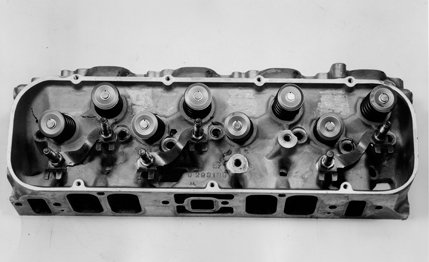It was the results of our Readers’ Choice poll that suggested to us that it was high time we tested another Corvette, but which one? There are two basic body types (the coupe and the convertible hardtop); two basic engines (the 327 and the 427); three basic transmissions (the 2-speed Powerglide and 3- and 4-speed manuals); and a staggering variety of options that can turn the Corvette into anything from a luxury two-seater to an all-out racer — and everything in between. We last tested a Corvette in our October ’65 issue; a very strong 427, all sturm und drang. Our own personal preference was the 327 cu. in., 350-hp hydraulic lifter engine (C/D, January ’65) because it is lighter, better balanced, and more responsive than the 427. It’s also a lot more practical for everyday street driving. But when we contacted Duntov, he talked us into testing a new version of the 427, with a 3 x 2-barrel carburetion setup and aluminum heads.
|
|
This engine, Duntov claimed, is only 40 lbs. heavier than the cast iron 327 — and it is weight that is removed from the front end. The cylinder heads alone save 75 lbs. Sure enough, this 427 Corvette weighs 43 lbs. less than the last 327 we tested, and it’s distributed 46/54% to the 327’s 47/53.
The heart of the new carburetion system is a unique air-operated system of controlling the throttle plates of the end carbs; only the center carb is mechanically connected to the accelerator pedal. An all-mechanical linkage bogs down if the throttle is punched at low speeds. Other manufacturers have tried manifold vacuum to control the secondary carburetors, but it has never been as successfully worked out as on this car. The new system operates the secondaries from the venturi vacuum in the primary carb. It results in an astoundingly tractable engine and uncannily smooth engine response. With a venturi area about the size of a barn door, it’s possible to drive off in high gear with very little slipping of the clutch or feathering of the throttle. As soon as it’s rolling, say at 500 rpm, you can push the throttle to the floor and the car just picks up with a turbine-like swelling surge of power that never misses a beat all the way up to its top speed of over 140 mph. And you get the same response — instantly — in any gear any time you open the tap. The only drawback of the system is when you back off from full throttle at engine speeds over 5500 rpm (1000 rpm under the redline). The secondaries don’t close immediately — it takes about 2/10ths of a second — because the air linkage isn’t as fast or as positive as mechanical operation. On the whole, the Corvette’s three deuces are as smooth and responsive as fuel injection.
|
|
This engine is regular production option, coded L89 (so you know what to ask for), but it isn’t quite the end of the line. There is an even more powerful, Instant Immortality engine, coded L88, for megalomaniacs only. The L88 also has the aluminum heads (which feature larger exhaust valves — 1.84 inches vs. the standard 1.72), but with a toilet-sized single four-barrel sitting atop a hogged-out manifold. All the 427s have a suggestive hood bulge, but the L88 alone has an air intake at the rear of the hood which ducts cold air directly on the carb. The air cleaner is attached to the hood itself, and mates with the carb base via a big, spongy O-ring when the hood is closed. The L88 is all set up as if for racing — with blueprint tolerances and all the right parts — to save competitors the time and expense of tearing down a standard 427 and rebuilding it with balanced racing pistons, etc. The L88 is rated at 435 hp, like the L89, but we were almost afraid to try it. Just listening to it idle, we knew it must have over 500 real horsepower, and besides, it was Friday the 13th. Back to the safe and sane L89.
View Photos
View Photos


Leave a Reply